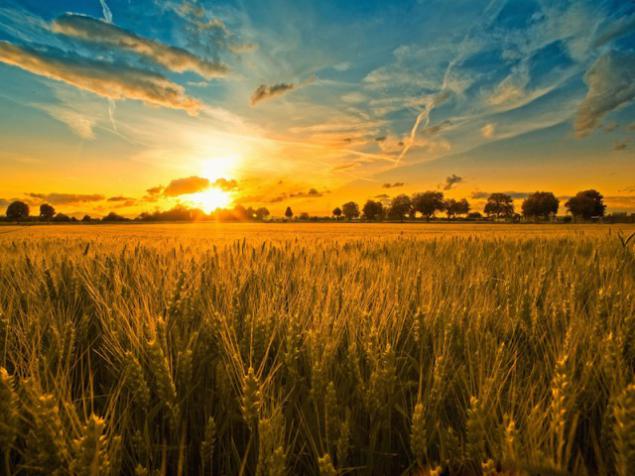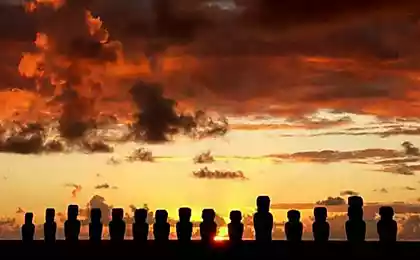691
10 things you did not know about the summer solstice
The longest day in goduLetnee solstice this year is celebrated on 21 June. In some cultures, the Northern Hemisphere is this day is considered the beginning of the summer. So, relax in the hot sunlight, and learn some interesting things about this wonderful day.

1. The exact date of the solstice does not exist, because the calendar does not accurately reflect the rotation of the Earth, but it is always celebrated between 20 and 22 June. This year, the Sun reaches its greatest height on June 21 at 20:38 Moscow time and will begin astronomical summer.
2. Solstice is so named because the Sun in the day (and a few days before and after), it seems, does not move from the place, frozen in the zenith of the whole day. On other days, the tilt of the Earth on its axis causes the "movement" of the Sun across the sky during the day.
3. The largest fire in the world was razozhzhёn the summer solstice. It happened in 2010 in Aalesund (Norway), where a celebratory fire reached 40, 5 meters in height.
4. The hottest summer weather set in a few weeks after the day of the solstice. It would be logical to assume that the position of the sun at its zenith should cause very hot weather, but the Earth is covered with water having a large heat capacity, that is, it takes a long time to warm up or cool down. Therefore, the heat "catches" us about six weeks after the day of the solstice.
5. Thousands of people gather at Stonehenge to mark the summer solstice. It is widely believed that Stonehenge was a place of ancient festivals of the Druids, as the construction of carefully aligned with respect to the visual line position of the sun. While the relationship between the ancient Celtic celebrations of the solstice and Stonehenge is not proven, today thousands of modern pagans prizzhayut to England these days. Last year, the festival was attended by 37,000 people.
6. In ancient Egypt, the Solstice was the first day of the new year. Egyptians noticed that before this day the sky appears the star Sirius, which was believed to have contributed to the great flood of the Nile River, which played a huge role in agriculture. Therefore, in the Egyptian calendar, the year began with voshestviem Sirius, immediately after the solstice.
7. In ancient China, the summer solstice "switched" yin yang on, and winter - back. Yin and yang were considered the foundation of all things, and their interaction and struggle - the source of all the elements and the whole variety of the world around us. Until the day of the summer solstice world is ruled by yang, and then until the day of the winter solstice - yin.
8. In ancient Greece, the summer solstice was the day of the general social equality. On this day the Greeks praise Cronus, the god of agriculture, and the servants took part in the celebrations on a par with the free people, without any restrictions.
9. It is logical to assume that in the hottest day of the summer solstice the sun is closer to the Earth than on a cold winter solstice. But in fact the opposite is true, as the summer heat is due to the slope of the Earth relative to the Sun, not the proximity to it.
10. Ironically, the lightest day of the year, the summer solstice, is one of the darkest in the history of science. On this day, June 22, 1633, kneeling Galileo, over which there was a process, before the court has recognized the false teachings of Copernicus that the "sun, not the Earth, is at the center of the world, and that the latest moves, including revolves around Sun in one year ».
via mentalfloss.com/article/64980/15-things-you-probably-didnt-know-about-summer-solstice

1. The exact date of the solstice does not exist, because the calendar does not accurately reflect the rotation of the Earth, but it is always celebrated between 20 and 22 June. This year, the Sun reaches its greatest height on June 21 at 20:38 Moscow time and will begin astronomical summer.
2. Solstice is so named because the Sun in the day (and a few days before and after), it seems, does not move from the place, frozen in the zenith of the whole day. On other days, the tilt of the Earth on its axis causes the "movement" of the Sun across the sky during the day.
3. The largest fire in the world was razozhzhёn the summer solstice. It happened in 2010 in Aalesund (Norway), where a celebratory fire reached 40, 5 meters in height.
4. The hottest summer weather set in a few weeks after the day of the solstice. It would be logical to assume that the position of the sun at its zenith should cause very hot weather, but the Earth is covered with water having a large heat capacity, that is, it takes a long time to warm up or cool down. Therefore, the heat "catches" us about six weeks after the day of the solstice.
5. Thousands of people gather at Stonehenge to mark the summer solstice. It is widely believed that Stonehenge was a place of ancient festivals of the Druids, as the construction of carefully aligned with respect to the visual line position of the sun. While the relationship between the ancient Celtic celebrations of the solstice and Stonehenge is not proven, today thousands of modern pagans prizzhayut to England these days. Last year, the festival was attended by 37,000 people.
6. In ancient Egypt, the Solstice was the first day of the new year. Egyptians noticed that before this day the sky appears the star Sirius, which was believed to have contributed to the great flood of the Nile River, which played a huge role in agriculture. Therefore, in the Egyptian calendar, the year began with voshestviem Sirius, immediately after the solstice.
7. In ancient China, the summer solstice "switched" yin yang on, and winter - back. Yin and yang were considered the foundation of all things, and their interaction and struggle - the source of all the elements and the whole variety of the world around us. Until the day of the summer solstice world is ruled by yang, and then until the day of the winter solstice - yin.
8. In ancient Greece, the summer solstice was the day of the general social equality. On this day the Greeks praise Cronus, the god of agriculture, and the servants took part in the celebrations on a par with the free people, without any restrictions.
9. It is logical to assume that in the hottest day of the summer solstice the sun is closer to the Earth than on a cold winter solstice. But in fact the opposite is true, as the summer heat is due to the slope of the Earth relative to the Sun, not the proximity to it.
10. Ironically, the lightest day of the year, the summer solstice, is one of the darkest in the history of science. On this day, June 22, 1633, kneeling Galileo, over which there was a process, before the court has recognized the false teachings of Copernicus that the "sun, not the Earth, is at the center of the world, and that the latest moves, including revolves around Sun in one year ».
via mentalfloss.com/article/64980/15-things-you-probably-didnt-know-about-summer-solstice
Creepy screaming infants as a means of combating air pollution
"Dinner in the sky" restaurant, which hovers in the clouds























